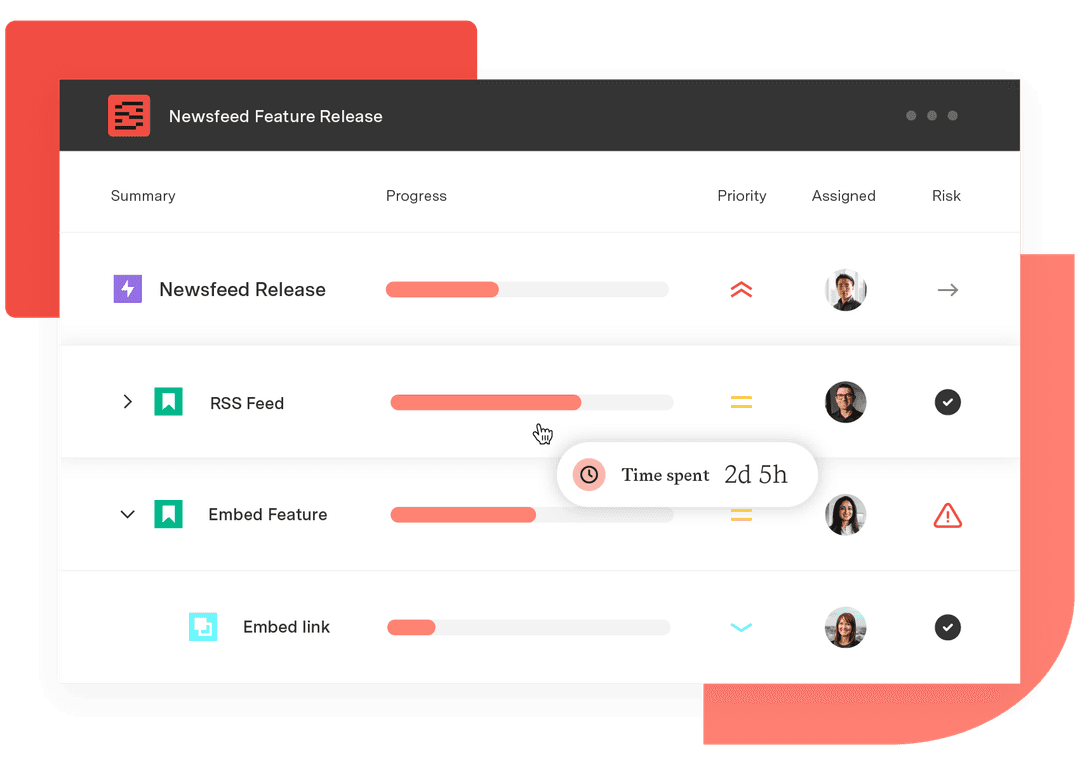From project thinking to program outcomes
Tempo Team
Your organization runs dozens of projects across multiple teams. Each project manager reports green status, and yet somehow, your biggest initiative is behind schedule, and stakeholders are losing confidence.
This scenario plays out in organizations everywhere. The problem isn't poor project management – it's project thinking applied to program challenges.
"Project management is like juggling three balls: time, cost, and quality. Program management is like a troupe of circus performers standing in a circle, each juggling three balls and swapping balls from time to time." - Geoff Reiss
When you manage a collection of interconnected projects as separate entities, you lose sight of the bigger picture and miss the dependencies that make or break program success.
Program thinking changes everything. Instead of tracking projects in isolation, you coordinate related work as unified programs with shared outcomes – taking the best approach to meet broader organizational goals.
This guide shows you how to make that shift. We'll explore five key capabilities that transform project chaos into program clarity.

Why project thinking fails at scale
Project management works well for discrete deliverables with clear boundaries. But most organizational initiatives today involve multiple teams, shared resources, and complex interdependencies.
When you apply project thinking to these situations, several problems emerge.
Visibility gaps hide program risks. Each team reports their progress separately, making it difficult to see how individual delays impact the overall program. A two-week slip in one project might trigger cascading delays across three other teams, but you don't discover this until it's too late to adjust.
Unmanaged dependencies create bottlenecks. Teams focus on their own deliverables without fully understanding how their work enables or blocks others. Critical handoffs get missed. Resources get allocated without considering downstream impacts.
Capacity misalignment leads to burnout. Teams might appear "on track" individually while being severely overcommitted across multiple programs. This leads to quality problems, missed deadlines, and team burnout.
Stakeholder alignment becomes impossible. Without program-level visibility, stakeholders receive fragmented updates that don't provide clear insight into overall progress or risks. This leads to constant requests for status updates and erodes confidence in delivery.
Inconsistent processes create coordination overhead. When every team uses different workflows, reporting formats, and planning approaches, program coordination becomes a full-time job. You spend more time translating between different approaches than actually managing delivery.
Program thinking addresses these challenges by treating related projects as components of larger programs with unified outcomes, shared dependencies, and coordinated execution.
Benefits of program-level thinking
Improved alignment: Throughout the strategic lifecycle, across the organization, in and across teams
Greater effectiveness: Deliver work that drives organizational value, eliminate the wrong work and align team capacity, minimize disruption through change
Reduced time to value: Better decisions in less time, shorter change implementation windows, better engagement and productivity.
Improved ROI: Better investment decisions, faster identification of variances, greater organizational agility, improved resource utilization

The five capabilities of program success
Successful programs require five essential capabilities that go beyond traditional project management. These capabilities work together to boost resilience, coordination, and adaptability:
1. Program roll-ups and roadmaps
Understand your entire program, not just projects
Program visibility starts with seeing both the forest and the trees. Instead of managing individual project schedules in isolation, you need consolidated views that show how all related work contributes to program outcomes.
Program roll-ups allow you to group related projects in a shared view, making it possible to track progress across teams and identify risks early. You can spot potential conflicts and coordination opportunities that would remain invisible in project-level views.
Cross-team roadmaps reveal timeline dependencies and resource conflicts before they impact delivery. You might discover that two teams are planning major releases in the same week, creating a support nightmare you can prevent with better coordination.
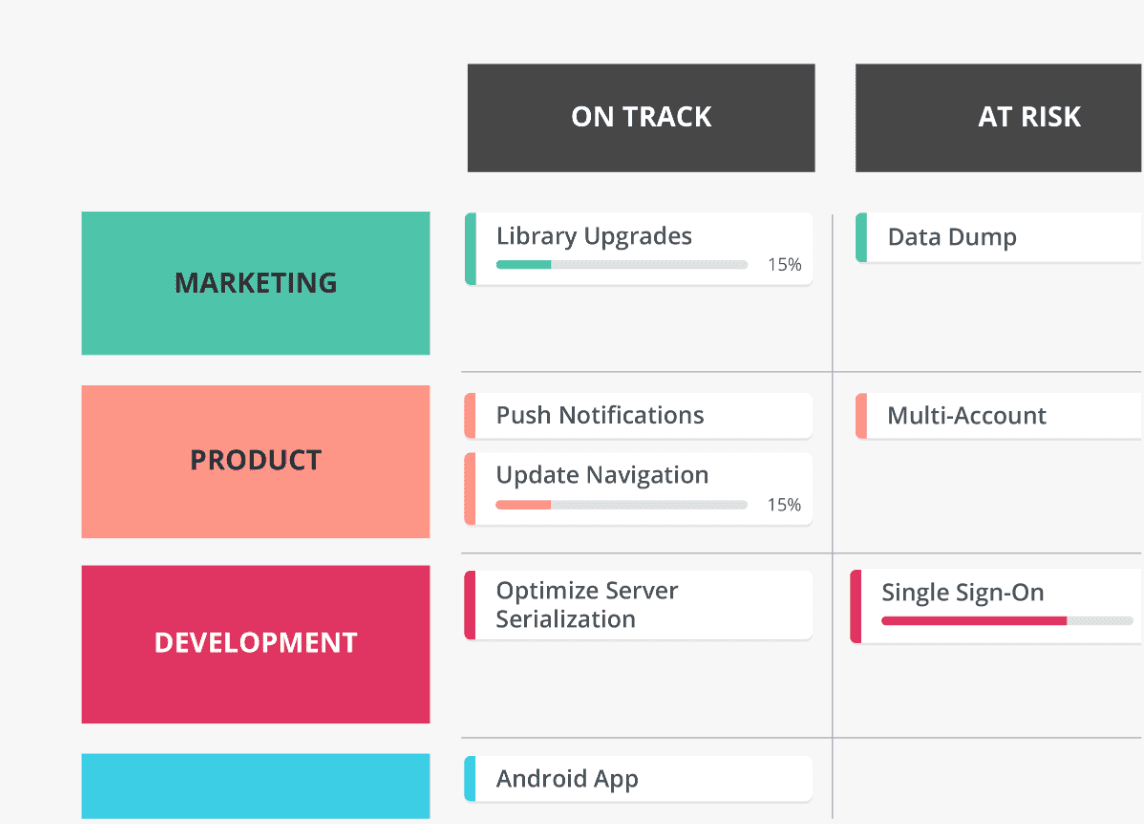
Spot slippage early with visual progress tracking. Traditional project reports show individual completion percentages, but program views show how those percentages translate to overall program health. A 10% delay in a critical path project has very different implications than the same delay in a non-blocking workstream.
Tempo Structure PPM offers exactly this kind of program visibility through hierarchical portfolio views and cross-team roadmaps. Instead of chasing status updates from multiple project managers, you see consolidated progress in real time with the ability to drill down into specific projects when needed.
Group projects by outcome, not just team structure. The most effective program views organize work around shared outcomes rather than organizational boundaries. A customer experience improvement program might include contributions from engineering, design, marketing, and operations – all supporting the same business goal.
2. Control dependencies and schedules
Understand where time, people, and spend is allocated
Dependencies are where programs succeed or fail. One missed handoff doesn't just impact a single deliverable – it creates ripple effects across interconnected teams, pushing deadlines and undermining stakeholder confidence.
Most project management approaches handle dependencies reactively. Team A finishes their work and then notifies Team B that they're ready for the handoff. But in complex programs, this approach creates constant surprises and scheduling conflicts.
Plan with Gantt charts, milestones, and baselines. Visual scheduling tools make dependencies explicit and help you coordinate delivery dates proactively. When you can see that Team B's work depends on Team A's API specifications, you can ensure the handoff happens on schedule and prepare contingency plans if it doesn't.
Milestones create accountability checkpoints that keep dependent teams aligned. Instead of waiting for complete deliverables, teams can coordinate around intermediate milestones that reduce overall program risk.
Baselines help you track scope creep and timeline drift against original commitments. When stakeholders request changes, you can quickly assess the impact on dependent projects and make informed decisions about trade-offs.
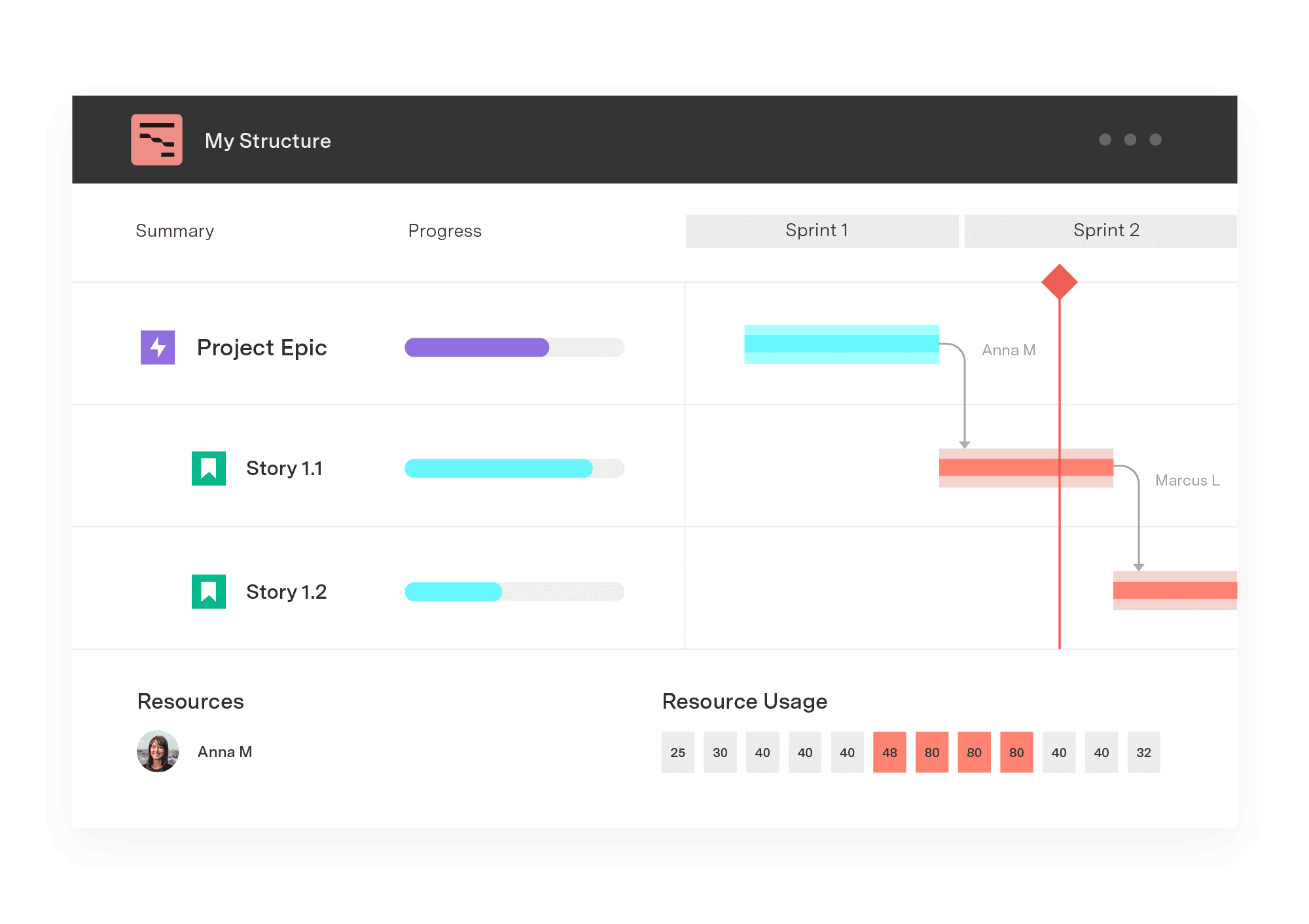
Coordinate dates without constant check-ins. The goal isn't to eliminate dependencies – that's impossible in complex programs. Instead, you need systems that make dependencies visible, add automations to task handoffs, and help teams coordinate their work without constant manual guidance.
Tempo Structure Advanced includes Gantt functionality that excels at visualizing and managing complex dependency networks. You can see potential bottlenecks before they materialize and take corrective action.
3. Balance capacity and resource alignment
Ensure people are working on the right projects at the right time
Here's a common program management paradox: teams can appear "on track" according to their schedules while simultaneously heading toward failure due to capacity misalignment. Perfect timelines mean nothing if your teams don't have the bandwidth to execute them.
Traditional project tracking focuses on when work should be done, not whether teams actually have the capacity to do it. You might have beautifully planned Gantt charts, but if your critical team is simultaneously supporting three other high-priority initiatives, those timelines become fantasy documents.
Compare demand and availability in real time. Effective capacity management requires understanding how much work needs to be assigned – and how much productive time teams actually have. This means accounting for meetings, time off, global holidays, support tasks, technical debt, and unexpected firefighting that consume capacity.
The most successful program managers track leading indicators like team velocity trends, overtime patterns, and quality metrics that signal capacity problems before they become delivery problems.
Rebalance workloads. When you can see capacity conflicts early, you have options. You can shift less critical work to future sprints, reallocate resources between projects, or adjust delivery timelines while stakeholder expectations are still flexible.
Tempo Capacity Planner provides real-time capacity visibility. Instead of guessing whether teams can handle their assigned work, you can analyze demand versus availability across your entire program and make workload adjustments based on data.
Protect timelines through resource planning. The best program schedules account for realistic team capacity from the beginning. This means planning with actual availability rather than theoretical capacity, and building in buffers for the unexpected issues that always arise.
4. Build consistency with standards and controls
Drive consistent delivery across teams
Inconsistent structures and permissions create chaos at scale. When every team uses different field definitions, workflow states, and reporting formats, program coordination becomes nearly impossible. You spend more time translating between different approaches than actually managing the program.
The solution is establishing shared standards that enable coordination while preserving team autonomy. This doesn't mean forcing every team into identical processes – it means creating common foundations that support program-level visibility and control.
Use shared structures, fields, and permissions. Consistent data structures make program roll-ups possible. When teams use the same fields for priority, status, and risk assessment, you can create meaningful program-level reports without manual data translation.
Shared permissions ensure that program managers can see cross-team progress without compromising team autonomy. Teams maintain control over their day-to-day work while providing the visibility needed for program coordination.
Enable predictable delivery with templates. Project templates establish proven patterns for common types of work. Instead of starting from scratch each time, teams can use templates that include appropriate workflows, permissions, and reporting structures.
The key is balancing standardization with flexibility. You need enough consistency to enable program coordination, but enough flexibility to accommodate different team needs and project types.
Structure PPM supports this approach through shared structures and permission models that work across multiple teams and projects. Teams can customize their internal processes while contributing to consistent program-level visibility.
5. Keep stakeholders aligned with reporting and updates
Share status, risks, and KPIs without endless meetings
Nothing kills program momentum like constant status meetings. Yet stakeholders need timely, relevant updates to make informed decisions and maintain confidence in program delivery. The challenge is providing transparency without creating administrative overhead.
Automated reporting solves this problem by keeping stakeholders informed without interrupting team productivity. When status, risks, and KPIs update automatically based on actual project progress, leaders can stay engaged without becoming bottlenecks.
Design dashboards for different audiences. Executive dashboards focus on high-level progress, budget consumption, and strategic risks. Team lead dashboards emphasize resource allocation, dependency status, and tactical issues. Individual contributor views highlight immediate priorities and blockers.
Schedule reports to maintain regular communication. Instead of ad-hoc status requests, establish regular reporting cycles that provide consistent updates to different stakeholder groups. This reduces interruptions while ensuring everyone has the information they need.
Tempo Custom Charts for Jira enables sophisticated stakeholder communication through real-time dashboards and scheduled reports tailored to different audience needs. Teams focus on delivery while stakeholders stay informed through automated updates.

Implementation: making the shift to program thinking
Moving from project thinking to program outcomes requires both organizational change and the right tools. Here's how to approach the transition systematically.
Start with program structure. Begin by grouping related projects under common program umbrellas. This might mean reorganizing your existing work or establishing new program categories that reflect shared outcomes rather than team boundaries.
Tempo's Structure Advanced provides hierarchical portfolio views that make this reorganization straightforward. You can establish program hierarchies that roll up project progress while maintaining team autonomy over day-to-day execution.
"Our mission is simple: Bring structure to chaos. When we solve this for program managers, their day-to-day transforms. They stop spending their time herding cats and are able to stay focused on driving meaningful outcomes." - Vic Chynoweth, CEO at Tempo Software
Establish dependency visibility. Map the critical handoffs between teams and projects. Focus on the dependencies that pose the highest risk to program success. Use visual tools to make these relationships explicit and trackable.
The Gantt functionality in Structure Advanced helps you visualize complex dependency networks and coordinate delivery dates across multiple teams.
Implement capacity planning. Start tracking team capacity alongside project schedules. This doesn't require perfect precision – even rough capacity estimates will reveal overcommitment patterns that threaten program delivery.
Tempo Capacity Planner integrates with your existing Jira projects to provide demand versus availability analysis without requiring teams to change their working methods.
Standardize key processes. Identify the minimum set of standards needed for program coordination. This typically includes common fields for priority and status, shared permission models, and consistent reporting formats.
Structure Advanced supports flexible standardization through shared structures and templates that teams can customize while maintaining program-level consistency.
Automate stakeholder communication. Replace manual status updates with automated dashboards and scheduled reports. Focus on providing the right information to the right audiences at the right frequency.
Custom Charts for Jira creates real-time dashboards and automated reports that keep stakeholders informed without requiring manual updates from teams.
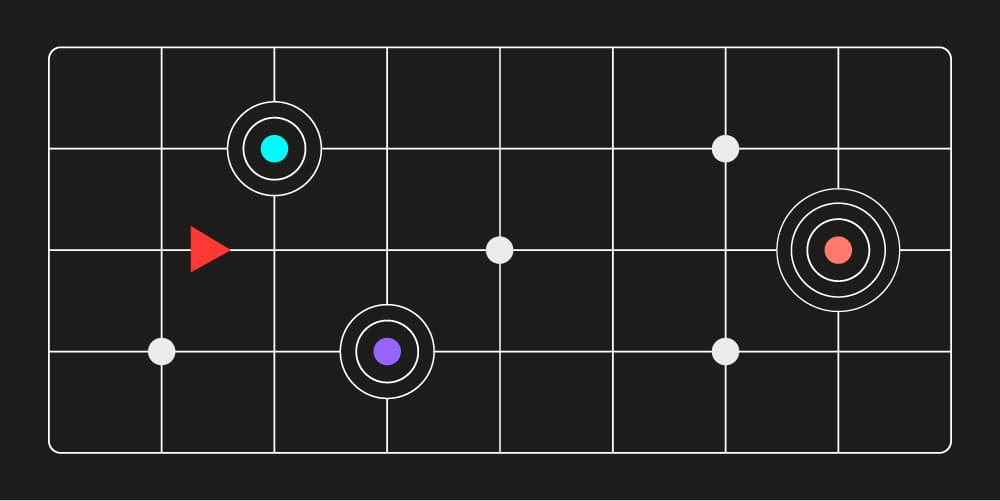
Who benefits from program thinking
Program management capabilities serve different roles in different ways, but everyone benefits from better coordination and visibility.
Program managers and delivery leads get cross-team visibility, dependency control, and on-time delivery. Instead of chasing status updates and discovering conflicts after they occur, you can proactively manage program risks and keep delivery on track.
PMO directors and portfolio analysts gain standards, status, and data for decisions. Consistent processes and automated reporting provide the insights needed for portfolio optimization and strategic planning.
Product owners and team leads receive shared schedules, clear priorities, and predictable commitments. When dependencies are visible and capacity is balanced, teams can make reliable commitments and focus on delivery rather than coordination overhead.
Jira administrators value scalable structures, permissions, and performance. Program management tools that work within Jira leverage existing investments while providing the additional capabilities needed for complex program coordination.

The result: clarity and control at scale
Organizations that successfully shift from project thinking to program outcomes achieve several key benefits that transform their ability to deliver complex initiatives.
Create a single source of truth for programs and portfolios. Instead of maintaining separate tracking systems for different initiatives, everything rolls up into unified program views that provide clear insight into progress, risks, and resource allocation.
“Tempo’s Program Collection provides a single source of truth that gets teams aligned and reduces complexity. It’s a game changer to have hierarchy views, formulas, and automations that connect every moving part.” – Paulo Bonamigo, Sales Manager at e-Core
Ensure consistent delivery processes across teams. Shared standards and templates reduce coordination overhead while maintaining team autonomy. Teams spend more time on delivery and less time on administrative coordination.
Adapt quickly with real-time insights and governance controls. When you can see program health in real time, you can respond to changes and challenges while options still exist. Problems become opportunities for proactive management rather than reactive firefighting.
Align resources for maximum delivery capacity. Balanced workloads and clear priorities ensure that people work on the right projects at the right time. This reduces context switching, prevents burnout, and maximizes the value delivered from your existing team capacity.
Case study: OTP Bank
As a quickly growing financial group, OTP Bank faced the complex challenges of expanding into new territories and adding subsidiaries. To scale effectively, OTP implemented Structure PPM, Capacity Planner, and Timesheets to standardize key workflows.
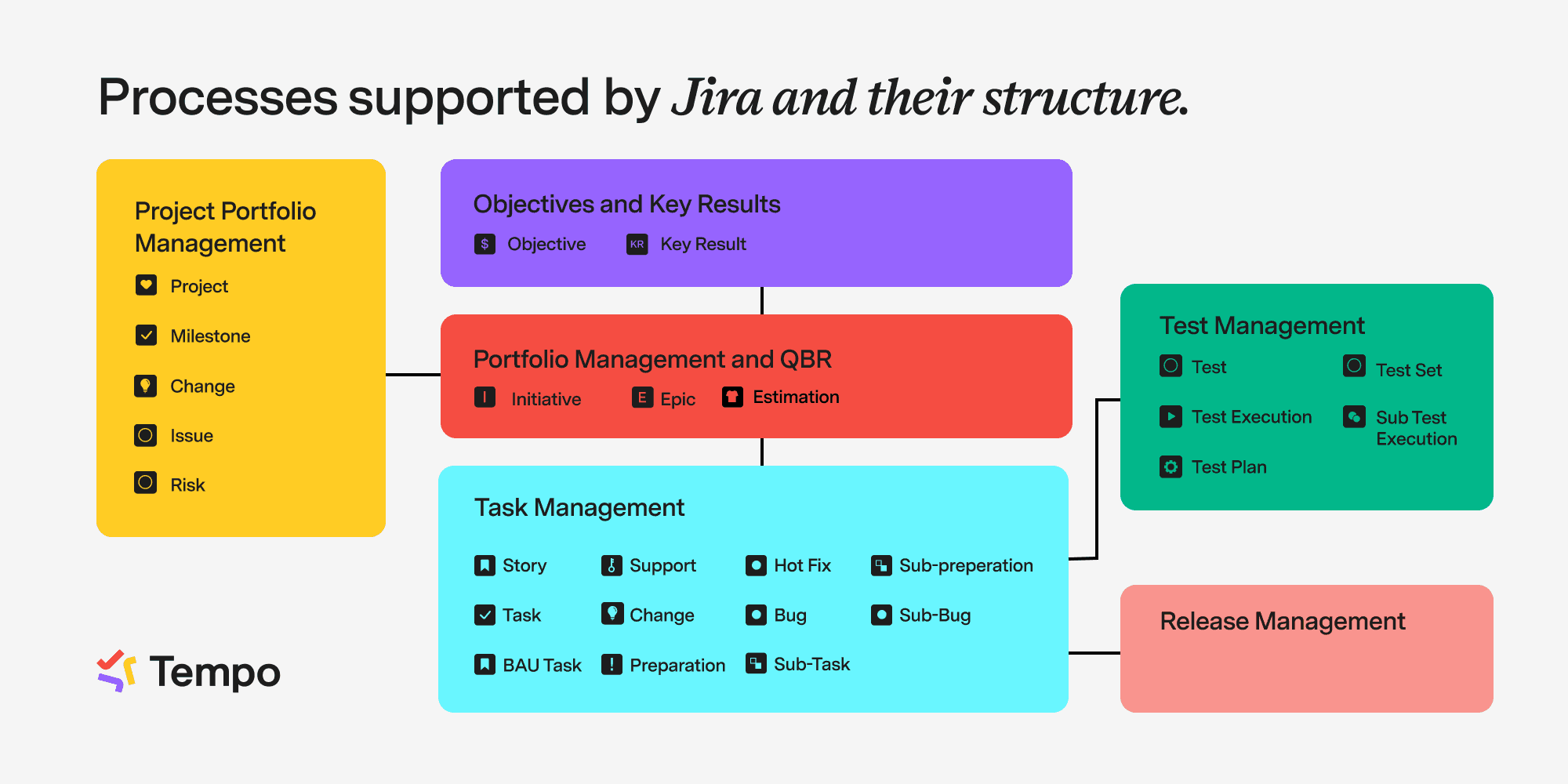
From executive OKRs to team backlogs, Structure provides a flexible, hierarchical view of work across all levels of the bank.
Leadership alignment: With top-level OKRs being tracked in Structure, OTP gained clear oversight of ongoing initiatives.
QBR planning: Team leads now have custom views for quarterly planning, delivery reporting, and resource estimation.
Agile at scale: Hundreds of teams now use tailored structures to manage backlogs, track epics, and visualize progress with Gantt Charts.
As a result of implementing Tempo tools, OTP has standardized enterprise planning across 10 subsidiaries, achieved DORA and GDPR compliance, improved vendor billing accuracy, strengthened audit readiness, and enabled full visibility from OKRs to stories across hundreds of teams.
“Tempo helps us see everything – from the top of the org to the delivery floor. That’s real enterprise agility.” Gergo Papp, CoE Lead, OTP Bank Group
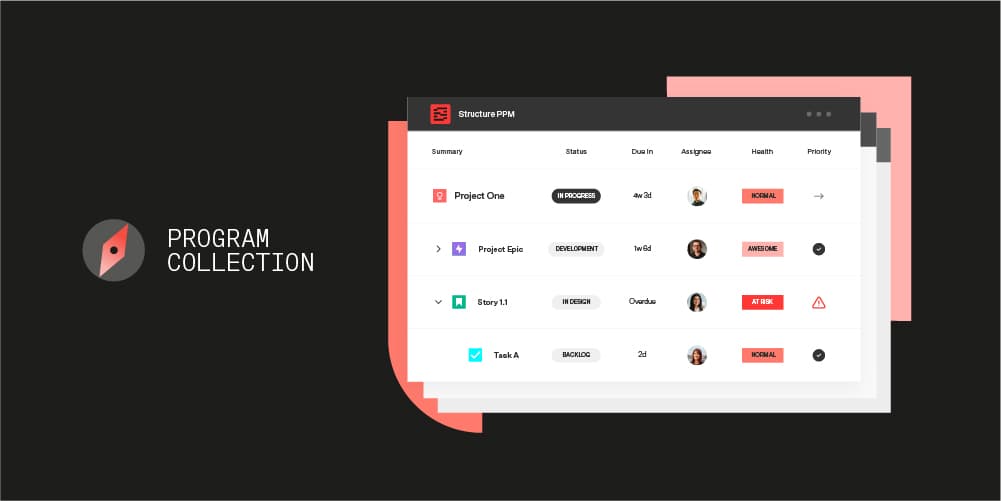
Getting started with Tempo's program management suite
Tempo's integrated program management tools make the shift from project thinking to program outcomes practical and achievable within your existing Jira environment.
Tempo Structure PPM provides hierarchical program views, cross-team roadmaps, and Gantt-based dependency management. You can group projects by outcome, visualize progress across teams, and coordinate delivery dates without leaving Jira.
Tempo Capacity Planner offers integrated capacity planning that compares demand against availability and helps you rebalance workloads before problems occur. Real-time capacity insights ensure that your program timelines reflect realistic team availability.
Tempo Custom Charts for Jira enables real-time reporting with dashboards and scheduled reports tailored to different stakeholder needs. Teams focus on delivery while stakeholders stay informed through automated updates.
Together, these tools provide the essential capabilities needed for program success: visibility, dependency control, capacity alignment, consistent standards, and stakeholder communication.
Organize and manage complex programs with clear, consolidated views.
See the Program CollectionThe shift from project thinking to program outcomes is about fundamentally different approaches to coordination, visibility, and control. But with the right capabilities in place, you can build programs that adapt to change, deliver predictable outcomes, and maintain stakeholder confidence even in volatile environments.
Your projects don't exist in isolation. It's time to manage them as the interconnected programs they really are.


